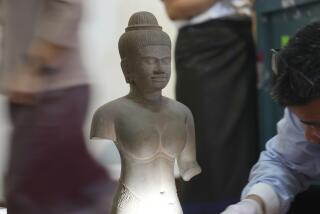Kuwaiti Treasures to Go on U.S. Tour : Art: State Department gives approval for exhibition of 107 pieces of ancient Islamic artworks.
- Share via
The U.S. State Department has given permission for a long-planned tour of rare treasures from the Kuwait National Museum to enter this country, according to officials at the Trust for Museum Exhibitions, which organized the tour.
“The plans for the tour were completely in place and approved before the invasion of Kuwait, but then everything changed,” said Joan Michelson, administrator of the Washington-based trust. “We had to begin a staggering round of international negotiations to keep it on track.”
The tour of 107 Islamic art pieces from about 100 to 1,000 years old will open at the Walters Art Gallery in Baltimore and then appear at museums in Atlanta, Richmond, Va., and St. Louis before heading for Canada. It will then perhaps go on to Europe, depending on how well the art holds up to the rigors of touring.
Significantly, the very survival of the art objects--including textiles, ceramics, illuminated manuscripts, jewelry and carved metal pieces--can perhaps be credited to the tour. The exhibition had just arrived at its first tour stop, the Hermitage in Leningrad, when Iraq invaded Kuwait on Aug. 2.
Those pieces on tour represent only a fraction of the priceless holdings of the museum in Kuwait City, which since 1983 has housed the collection amassed by Sheik Nasser Sabah al Ahmed al Sabah and his wife, Sheika Hussa. Sheik Nasser is the nephew of the exiled Emir of Kuwait and Sheika Hussa is the daughter of a former Emir.
Unconfirmed reports from occupied Kuwait say that Iraqis have removed at least a part of the collection from the museum. Sheika Hussa was out of the country when the invasion occurred and Sheik Nasser later escaped.
Plans for the U.S. tour were complicated by an executive order, in the wake of the invasion, barring the importation of objects from Kuwait. The trust had to obtain from the State Department a waiver and a guarantee that the objects would not be seized when in this country. Permissions had to be also obtained from the Treasury Department and various other federal agencies.
“Usually, these things are straightforward,” Michelson said. “But in this case, everyone in the government was afraid to be the one to give us the permission we needed. They all wanted someone else to sign off on it first.”
More to Read
The biggest entertainment stories
Get our big stories about Hollywood, film, television, music, arts, culture and more right in your inbox as soon as they publish.
You may occasionally receive promotional content from the Los Angeles Times.











